This expert DIY guide will teach you the basics of planting roses and caring for them, including staking and pruning roses.
Roses have some specific needs, and they are also more prone to certain pests and diseases than are other plants.
Still, roses are far sturdier than most people think, so choosing a plant that will do well in your climate, planting it in good soil in a prime growing location, and taking the time to meet its basic care needs will help keep problems at bay and make your roses no more troublesome than any other plant.
How to Plant Roses
Planting depth for roses varies, depending on your climate and whether your plant is growing on its own rootstock, called “own-root,” or has been grafted onto a different rootstock, called “grafted” or “budded.”
In mild-winter climates, own-root roses should be planted so that the junction where the canes meet is even with or just below the soil surface. In cold-winter areas, place own-root roses so the junction is about 1 inch below the surface.
In mild-winter climates, plant grafted roses so the bud union is just at or slightly above the surrounding soil. In cold-winter areas, if you want more canes, plant with the bud union just above the soil, and then protect the plant in winter by “tipping” (see Winter Protection for Roses). For fewer canes but more winter protection, place the bud union 1 to 2 inches below the soil.
Spacing is also important; roses do best when they’re not crowded. Hybrid teas and grandifloras should be 2 to 3 feet apart in cold climates and 4 to 8 feet apart in mild-winter climates, based on their final size. Floribundas and polyanthas can be placed much closer together, usually up to 3 feet apart, and miniatures can be 1 to 3 feet apart. Other shrub roses, old garden roses, and species roses should be 6 feet apart in cold-winter climates and 10 to 12 feet apart in warmer climates. Especially large roses, or those with canes that sprawl, should be given even more room.
Unless you’re planting a variety that can tolerate light shade, choose a spot that will get at least six hours of sunshine in the growing season. The exception would be areas with extremely hot summers; in these spots, roses benefit from light afternoon shade. Look for a spot with good air circulation, which helps prevent foliar diseases, but keep roses out of areas with consistent strong winds, which can tear at the leaves.
Roses do best in average soil—neither too acidic nor too alkaline—that drains reasonably well. If your soil is very sandy or heavy clay, you’ll want to amend the planting area with organic matter; for very poor soil, consider growing roses in raised beds.
Regular watering keeps plants healthy and promotes blooms. Other than that, your chores will consist of fertilizing, pruning, and keeping pests and diseases under control.
Remember: Rose thorns can be nasty. Whether you’re planting or caring for roses, or just cutting the blooms, use sturdy gloves and some arm protection.
Staking Roses
If you’re planting a standard rose or tree rose, you’ll need to stake it for the first year. Choose a stake that is 2 feet longer than the trunk or stem of the standard.
After digging the hole, but before placing the rose in it, set the stake into the ground to the side of the hole toward the prevailing wind. Drive the stake about 2 feet into the ground. Once you’ve planted the rose, check that the top of the stake is below the bud union.
With soft plastic tape, tie the stem to the stake near the top and about halfway down the trunk. Use a figure-8 pattern for the ties to prevent the stake from rubbing on the stem.
How to Plant Climbing Roses
If you’re planting a climber, you’ll need to provide support. This can be a fence, trellis, arbor, post, wall, or even tree. You can tie a rose to an open support system, such as a trellis or fence, with soft plastic ties (be sure to keep the ties loose).
Also be sure the structure is strong enough to hold the weight of the grown plant. Trellises, in particular, can be fairly lightweight; you may need to attach a trellis to a wall-framing system or posts. If you don’t, be sure to leave some space between the trellis and adjoining surface to let air circulate. Solid surfaces such as walls will need support wires added for attachment of the canes.
For a climber, make some adjustments to the basic planting instructions. If your plant is a rambler–a vigorous climber that can easily grow to the top of a house or tree–cut it back to almost ground level to encourage new shoots from the base. Don’t cut back other types of roses.
Make your planting hole about 1 1/2 feet away from your plant’s support structure. Set the plant in the hole at a 45-degree angle and lean the canes toward the support. If the lowest level of the support system is above the tops of the new canes, use temporary stakes to support the canes until they reach the permanent support.
Miniature roses should be set out as you would a regular container rose. If you’re planting a mini rose, give it time to acclimate to outdoor conditions by placing it outside in a sheltered spot for a few hours every day for several days. Set both miniature roses and mini roses slightly deeper in the soil than they were growing in their pots, and water frequently as their roots are shallow.
How to Prune Roses
The most basic type of pruning–called deadheading–has a number of benefits for the health of the rose and for you. Cutting off blooms encourages the plant to produce even more flowers.
Deadheading when the flower is just opening gives you great cut flowers for your home. Spending time deadheading each plant also lets you take a closer look at the health of the plant, helping you catch insect infestations or the onset of diseases before they get out of hand.
When deadheading, always cut back to a spot just above a leaf with five leaflets that is growing toward the outside of the plant. If your rose is full-grown and strong, look for a spot about two to three sets of leaves below the flower. For young plants or those that aren’t as sturdy, choose a leaf that is higher. Using sharp pruning shears, angle the cut at 45 degrees from the outside of the cane above the leaf to the inside of the cane.
Out-and-out pruning lets you shape your plant for a desired look. It also helps keep roses healthy and provides you with plenty of blooms.
When pruning, wear protective clothing and gloves. You can also buy arm protectors that fit over your sleeves to protect you from scratches. A jacket of thick material that won’t snag but will allow easy movement is also good. You’ll want a pair of sharp bypass pruning shears; use a small pruning saw for large canes or dead wood.
Pruning times depend on the flowering times. For repeat bloomers, late winter, during the dormant season, is best. If your springs tend to alternate between chilly winter days and warmer spring-like days, prune either when the forsythia is in bloom or 30 days before the last expected killing frost.
For roses that bloom only in spring, do your major pruning just after they bloom. You can remove old and diseased canes in winter, though.
Start by thinning, or removing entire shoots back to the base of the plant or to another, stronger cane. Thin out weak canes and dead wood. Cut out any branches that cross or that cut through the middle of the bush to encourage growth out. Once you’ve removed the branches you don’t want, cut back the remaining canes to encourage new growth and flowers.
Cut back hybrid teas and grandifloras by about a third (a little less for floribundas and polyanthas) in mild-winter regions and more heavily in cold-winter regions.
For old garden roses and shrub roses, just cut back the tips above a bud that is facing in the direction you want the new stem to grow. Use an angled cut of about 45 degrees. Cut away from the bud; the low point of the cut should be just slightly higher than the bud itself.
Miniatures and standards are pruned just as their parents are. If you’re cutting back canes that have been damaged by frost, be sure you cut back to healthy tissue; the center of the cane should be white.
To get rid of suckers–plants growing from the rootstock of a grafted or budded rose–grasp the sucker and pull it down and off the plant. Suckers that emerge from the ground should be pulled out from their source on the root of the plant.
Shearing is a good choice for hedges and large expanses of ground cover roses, but because it may slow down flower production, don’t use it on other types of roses. You can also cut ground covers back only as needed to remove diseased or old canes or those that are growing out of control.
Let climbers go unpruned for the first three years after you’ve planted and then thin to remove any damaged or diseased canes and the oldest canes on spring bloomers. Cut back to two or three buds all the remaining flowering side branches. Ramblers should be pruned after they flower by cutting back the ones that have flowered and have no new growth.
How to Care for Roses
Watering is the most important aspect of keeping roses healthy. Rose roots can reach up to a foot and a half deep, and they don’t like to dry out. Instead of watering often but shallowly, give roses regular deep waterings less frequently.
Many gardeners use flood basins, drip irrigation, or soaker hoses. Avoid overhead watering if possible; wet leaves can lead to fungal diseases. If you live in a dry-summer area, though, you may want to sprinkle the leaves to remove dust and dirt. Do so early on a warm and sunny day so the leaves will dry out before evening.
Container roses will need to be watered more often, particularly if the weather is hot and windy. For both container and in-ground roses, mulch can help retain moisture. If your ground does not freeze in winter, you will need to water if there are no winter rains.
There are any number of problems that can attack roses, from too little nutrients to sunburn to damage from a number of pests, including aphids, beetles, and caterpillars, and diseases, including blackspot, powdery mildew, and rust.
Don’t panic; very few roses are hit by all of these problems, and almost never at once. Sometimes it’s worth a little damage to encourage the good bugs, which in turn keep the bad bugs and diseases in check. Some preventative maintenance is usually all that’s required to keep your roses in good shape.
Your first step is to choose roses that will work well with your garden and to give them a good start with sunshine, well-draining soil, and regular watering. Get rid of dead leaves and spent flowers and trim off diseased canes.
Inspect your plants regularly, and use soapy water or a spray from a hose to remove many of the most common pests. Encourage the good bugs, such as ladybugs, lacewings, and even wasps. If you must use pesticides, consider natural and organic ones. Use them carefully, following instructions, and keep children and pets away. (For more information, see the section on Pest Control.)
Add fertilizer when you first plant the rose and then again after the first bloom. Repeat bloomers will need to be fertilized throughout the growing season.
Stop about six weeks before the first anticipated frost or, in mild-climate areas, in mid-October. In succeeding growing seasons, feed just after you’ve pruned and then again after the first bloom.
Continue to feed throughout the growing season for repeat-blooming roses. Some rose growers also add Epsom salts when they first fertilize, using about 1/2 cup per plant. They may also apply a bit more after the first bloom. Be careful not to over-fertilize, though; it will lead to brown leaves.
Winter Protection for Roses
In mild-winter climates, roses are generally hardy, though younger plants are more susceptible to cold weather. Stop fertilizing and deadheading (see Pruning Roses) in October to prepare for winter, though you’ll need to water if winter rains don’t come.
Strip off any remaining leaves, and clean up any fallen leaves and debris (some roses do remain evergreen in mild climates; you needn’t strip the leaves off them). Your roses should be fine until it’s time to prune.
In cold-winter climates, particularly in places where there are cycles of freezes and thaws, winter protection is more involved. Start by buying roses that do well in your region. Plant them in sheltered spots, and avoid low-lying areas where cold air collects.
Stop deadheading and fertilizing before the first frost, but continue watering until the ground freezes. Do a good garden cleanup in the fall to get rid of fallen leaves and dead and diseased canes. Strip off any remaining leaves as well.
There are two ways to protect plants: mounding and tipping. Mounding is good for areas with cycles of cold and warmth; tipping is preferred in areas with very cold winters.
Start mounding in early to mid-fall. Cut the canes back to about 3 feet, and tie them together. Mound up the soil to at least a foot higher than the base of the bush. Give the plant a good drink just before the first freeze, and then apply mulch over it.
Once the mound has frozen, cover it with an insulating layer of straw, hay, conifer branches, or other material that doesn’t compact. Hold this material in place by surrounding it with a sleeve made of wire mesh or a rose cone; be sure there is good air circulation around the plant.
Plants in extremely cold-weather areas should be tipped before the first frost. To tip a shrub rose, make a trench to one side of the plant. Loosen the roots on the other side of the plant and carefully bend the roots (not the trunk) until the plant lies in the trench. Tie the stems together and cover both roots and plants with soil. For a standard rose, dig a small trench for the trunk and a larger one for the canes. Loosen the roots on the side opposite the bud union. Bend the roots (not the trunk) over into the trench. Cover the entire plant with soil.
To protect climbing roses in areas where winter lows reach below -15 degrees F., take the canes from the support, lay them to one side, and cover them with soil. If temperatures range from -15 degrees F. to 5 degrees F., leave them in place, but insulate them with straw and cover them with burlap. In areas where winter lows reach from 5 degrees F. to 15 degrees F., use soil to cover non-hardy climbers.
Soil in containers often is much colder than ground soil. The best protection is to store the plant, container and all, in an unheated shed or other outbuilding until summer.



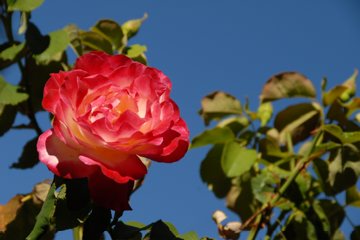
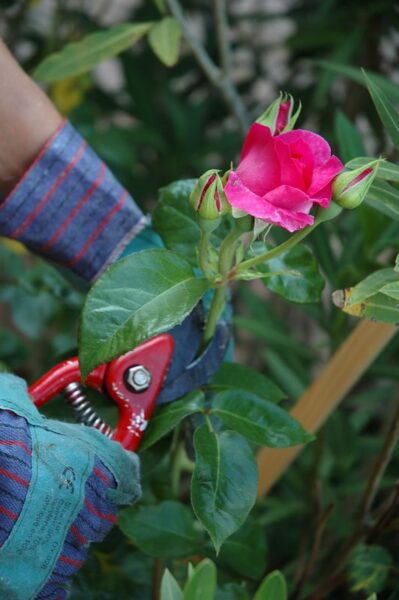
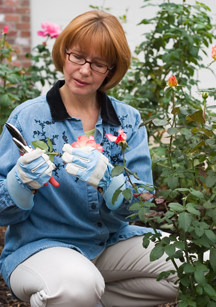
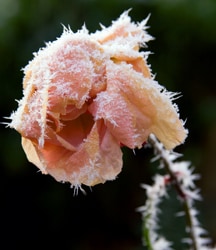

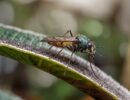


 Don Vandervort writes or edits every article at HomeTips. Don has:
Don Vandervort writes or edits every article at HomeTips. Don has:




